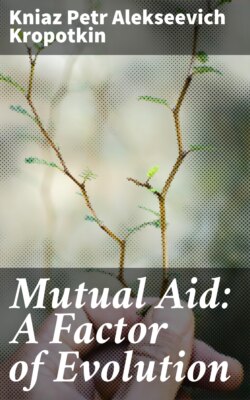Читать книгу Mutual Aid: A Factor of Evolution - kniaz Petr Alekseevich Kropotkin - Страница 6
NOTES:
Оглавление1. Origin of Species, chap. iii, p. 62 of first edition.
2. Nineteenth Century, Feb. 1888, p. 165.
3. Leaving aside the pre-Darwinian writers, like Toussenel, Fee, and many others, several works containing many striking instances of mutual aid—chiefly, however, illustrating animal intelligence were issued previously to that date. I may mention those of Houzeau, Les facultes etales des animaux, 2 vols., Brussels, 1872; L. Buchner's Aus dem Geistesleben der Thiere, 2nd ed. in 1877; and Maximilian Perty's Ueber das Seelenleben der Thiere, Leipzig, 1876. Espinas published his most remarkable work, Les Societes animales, in 1877, and in that work he pointed out the importance of animal societies, and their bearing upon the preservation of species, and entered upon a most valuable discussion of the origin of societies. In fact, Espinas's book contains all that has been written since upon mutual aid, and many good things besides. If I nevertheless make a special mention of Kessler's address, it is because he raised mutual aid to the height of a law much more important in evolution than the law of mutual struggle. The same ideas were developed next year (in April 1881) by J. Lanessan in a lecture published in 1882 under this title: La lutte pour l'existence et l'association pour la lutte. G. Romanes's capital work, Animal Intelligence, was issued in 1882, and followed next year by the Mental Evolution in Animals. About the same time (1883), Buchner published another work, Liebe und Liebes-Leben in der Thierwelt, a second edition of which was issued in 1885. The idea, as seen, was in the air.
4. Memoirs (Trudy) of the St. Petersburg Society of Naturalists, vol. xi. 1880.
5. George J. Romanes's Animal Intelligence, 1st ed. p. 233.
6. Pierre Huber's Les fourmis indigees, Geneve, 1861; Forel's Recherches sur les fourmis de la Suisse, Zurich, 1874, and J.T. Moggridge's Harvesting Ants and Trapdoor Spiders, London, 1873 and 1874, ought to be in the hands of every boy and girl. See also: Blanchard's Metamorphoses des Insectes, Paris, 1868; J.H. Fabre's Souvenirs entomologiques, Paris, 1886; Ebrard's Etudes des moeurs des fourmis, Geneve, 1864; Sir John Lubbock's Ants, Bees, and Wasps, and so on.
7. Forel's Recherches, pp. 244, 275, 278. Huber's description of the process is admirable. It also contains a hint as to the possible origin of the instinct (popular edition, pp. 158, 160). See Appendix II.
8. The agriculture of the ants is so wonderful that for a long time it has been doubted. The fact is now so well proved by Mr. Moggridge, Dr. Lincecum, Mr. MacCook, Col. Sykes, and Dr. Jerdon, that no doubt is possible. See an excellent summary of evidence in Mr. Romanes's work. See also Die Pilzgaerten einiger Sud-Amerikanischen Ameisen, by Alf. Moeller, in Schimper's Botan. Mitth. aus den Tropen, vi. 1893.
9. This second principle was not recognized at once. Former observers often spoke of kings, queens, managers, and so on; but since Huber and Forel have published their minute observations, no doubt is possible as to the free scope left for every individual's initiative in whatever the ants do, including their wars.
10. H.W. Bates, The Naturalist on the River Amazons, ii. 59 seq.
11. N. Syevertsoff, Periodical Phenomena in the Life of Mammalia, Birds, and Reptiles of Voroneje, Moscow, 1855 (in Russian).
12. A. Brehm, Life of Animals, iii. 477; all quotations after the French edition.
13. Bates, p. 151.
14. Catalogue raisonne des oiseaux de la faune pontique, in Demidoff's Voyage; abstracts in Brehm, iii. 360. During their migrations birds of prey often associate. One flock, which H. Seebohm saw crossing the Pyrenees, represented a curious assemblage of "eight kites, one crane, and a peregrine falcon" (The Birds of Siberia, 1901, p. 417).
15. Birds in the Northern Shires, p. 207.
16. Max. Perty, Ueber das Seelenleben der Thiere (Leipzig, 1876), pp. 87, 103.
17. G. H. Gurney, The House-Sparrow (London, 1885), p. 5.
18. Dr. Elliot Coues, Birds of the Kerguelen Island, in Smithsonian Miscellaneous Collections, vol. xiii. No. 2, p. 11.
19. Brehm, iv. 567.
20. As to the house-sparrows, a New Zealand observer, Mr. T.W. Kirk, described as follows the attack of these "impudent" birds upon an "unfortunate" hawk.—"He heard one day a most unusual noise, as though all the small birds of the country had joined in one grand quarrel. Looking up, he saw a large hawk (C. gouldi—a carrion feeder) being buffeted by a flock of sparrows. They kept dashing at him in scores, and from all points at once. The unfortunate hawk was quite powerless. At last, approaching some scrub, the hawk dashed into it and remained there, while the sparrows congregated in groups round the bush, keeping up a constant chattering and noise" (Paper read before the New Zealand Institute; Nature, Oct. 10, 1891).
